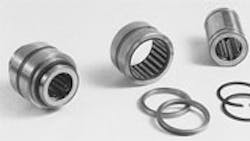Motor rolling-element bearings: Lubrication & maintenance
Q: I’m using linear bearings in a high-speed, heavily loaded application, but lubricant loss is high. What can I do?
A: The obvious answer is to use sealed bearings. Felt washer lip seals produce little friction and protect against some atmospheric dust. But they will not hold lubricant for long at high speed. Synthetic rubber lip seals provide better dirt exclusion and lubricant retention. Springloaded rubber lip seals are even more effective, but they do cause slightly more friction and are a bit more costly.
You might try reversing the seals so their lips point inward toward the bearing, or use a double-lip seal. Mounting in this way increases the seal’s ability to retain lubricant, but reduces its dirt-exclusion effectiveness.
Q: We’ve experienced high maintenance and premature bearing failure in an application where the shaft both rotates and travels axially. What can we do, if anything, to reduce maintenance and increase life?
A: Don’t use conventional recirculatingball linear bearings in shaft applications involving both linear and rotary motion. Rotation causes the balls to rub on ball retainers, producing deformation or wear, or both. But a special combination-bearing assembly consisting of a linear bearing mounted within a needle, roller, or ball bearing, does the trick. The radial, rotary bearing is centrally positioned on the outside of the fixed-diameter linear-bearing (which is a ground surface) with retaining rings or spacers. The linear bearing is free to rotate within the radial bearing while it also accommodates linear motion.
Be careful with such combination bearings when heavy loads combine with high rotational speeds, when acceleration and deceleration rates are high, or when rotary inertial forces are high. In these conditions, test a combination bearing before putting it into service.
Another approach to accommodating both linear and rotary motion has a special bearing unit designed for just this purpose. Outwardly it looks like a recirculating linear bearing. But internally, several rows of balls are retained in holes in a cylindrical retainer sleeve that fits between the shaft and an outer body. The stroke (maximum linear travel) of this type of bearing is limited.

